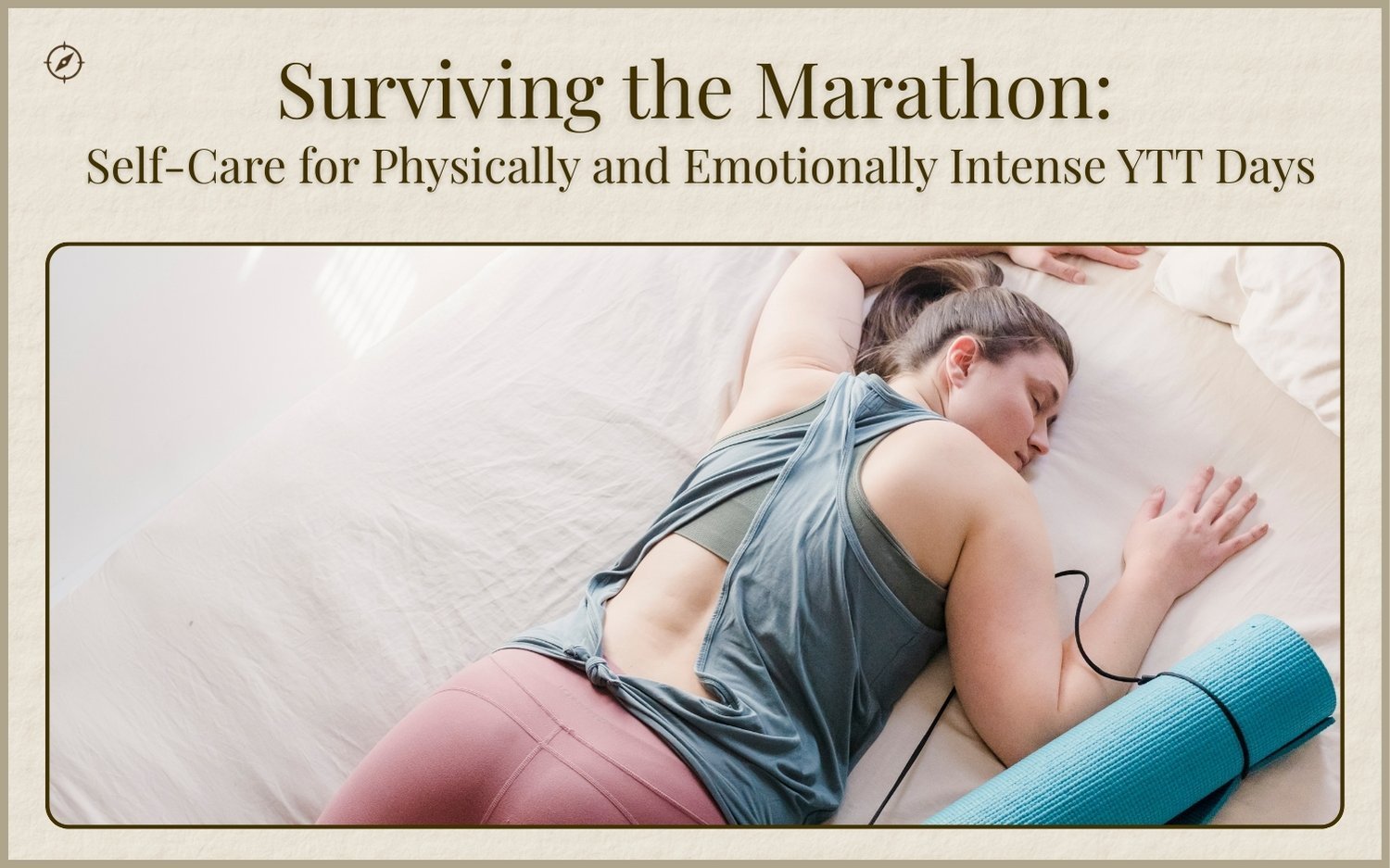Surviving the Marathon:
Self-Care for Physically and Emotionally Intense YTT Days

Yoga Teacher Training (YTT) can feel like running a marathon every single day — physically demanding, emotionally charged, and mentally intense. While it is an incredible opportunity for growth, the long days and packed schedules can take a toll if you do not manage your energy wisely. That is why self-care is not optional during YTT, it is your foundation for success.
This guide will walk you through practical strategies to keep your body strong, your mind clear, and your spirit uplifted from day one to graduation. Whether you are stretching into your fifth Downward Dog of the morning or navigating a deep emotional release in meditation, these tips will help you stay balanced and resilient.
This article is part of The Ultimate Guide to Yoga Teacher Training: Challenges and How to Overcome Them
Listen to Your Limits and Honor Rest
YTT is not the time to push through pain or ignore signs of exhaustion. Fatigue, irritability, and lack of focus are all indicators that your body and mind need recovery time. Keep a small journal to track your energy patterns throughout the week, notice when you feel most alert and when you crash. Use that information to plan micro-rest periods, whether it is a short nap, a quiet tea break, or a mindful breathing session.
Build Simple, Consistent Self-Care Rituals
In the whirlwind of YTT, predictability is a gift. Anchor your days with small, repeatable acts that signal “this is my time.” Examples include:
- Drinking a full glass of water upon waking
- Eating a nourishing breakfast before class
- Taking a 10-minute walk outside between sessions
- Doing a brief evening meditation before bed
These rituals create a steady rhythm that keeps you grounded, even when the schedule is intense.
Nourish Your Body Wisely
Fueling your body well is non-negotiable during YTT. Prepare healthy meals ahead of time so you are not scrambling between classes. Stick with foods you know work for your digestion instead of experimenting with extreme diets or trends during training.
Hydration is just as critical. Drink water before, during, and after practice. On particularly demanding days, consider adding electrolytes to your water to maintain energy levels.
Prioritize Sleep and Downtime

Recovery is where growth happens, both physically and emotionally. Aim for a consistent sleep schedule and create a nighttime routine that signals to your body it is time to rest. Options include:
- Gentle stretching or restorative yoga
- Yoga Nidra or guided meditation
- Reading something uplifting (no screens)
During the day, give yourself permission to do nothing between classes. Sit in the sun, lie on the grass, or simply close your eyes and breathe.
Schedule Bodywork and Gentle Movement
Long days of asana can lead to sore muscles and fatigue. Counteract that with restorative care: book a massage, take a yin yoga class, or go for an easy walk. Gentle movement outside the mat, like stretching or swimming, keeps blood flowing without overtaxing your system. Take epsom salt baths.
Set Boundaries and Protect Your Energy
During YTT, your time and attention are precious resources. Avoid overcommitting to social plans, extra work, or errands that can wait until after graduation. Saying “no” to non-essential activities allows you to say “yes” to rest, focus, and integration.
Practice Mindfulness and Reflection

Daily mindfulness practices help you stay emotionally steady and present.
Consider:
- Journaling before or after class to process new insights
- Sitting in silence for 10–30 minutes each morning
- Ending the day by listing three things you are grateful for
These practices help you integrate what you are learning on the mat into your life off the mat.
Build a Support Network
Do not go through YTT in isolation. Share your experiences with fellow trainees, mentors, or your broader yoga community. A simple check-in with a friend can lift your mood, provide perspective, and remind you that you are not alone in the journey.
Allow Time for Integration
After training ends, resist the urge to jump straight back into a packed schedule. Give yourself at least a day or two for quiet reflection, journaling, and rest. This downtime allows your body and mind to process the depth of the experience and carry it forward into your teaching.
Final Thoughts
Physically and emotionally intense YTT days can be demanding, but they are also some of the most rewarding you will ever experience. By building self-care into your daily rhythm, you can not only survive the training, you can truly thrive.
Check out The Ultimate Guide to Yoga Teacher Training: Challenges and How to Overcome Them for more pages that will support your journey.
